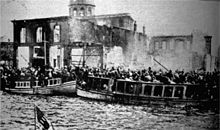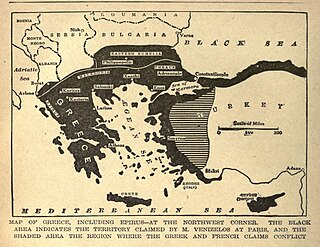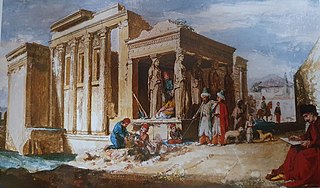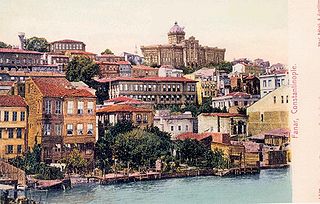Background
Greek and Turk relations: 6th–14th centuries

The Byzantine Empire although a different regime to the nation of Greece, factors into the nations modern relations as heritage. [1] Some view the Byzantine Empire (the Greek-speaking Eastern Roman Empire during the medieval era) as the medieval expression of a Greek nation and a pre-modern nation state. [2]
The Göktürks of the First Turkic Khaganate were the first Turkic state to use the name Türk politically. [3] The first contact with the Romans (Byzantine Empire) is believed to be 563. [4] [5] The 10th century saw the rise of the Seljuk Turks. [6]
The first conflict between the Byzantine Empire and Seljuk Turks occurred at the Battle of Kapetron in 1048. More notable is the Battle of Manzikert in 1071 and the Turkish settlement of Anatolia that followed. Later, Turkish Anatolian beyliks were established both in formerly Byzantine lands and in the territory of the fragmenting Seljuk Sultanate. [7] One of those beyliks was the Ottoman dynasty and become the Ottoman Empire. [8] In 1453, the Ottoman Empire conquered Constantinople, the capital city of the Byzantine Empire. [9]
The Rum Millet: 15th–19th centuries
All of modern Greece by the time of the capture of the Despotate of the Morea was under Ottoman authority, with the exception of some of the islands.
- Islands such as Rhodes (1522), Cyprus (1571), and Crete (1669) resisted longer due to other empires that came into power from the Frankokratia days
- The Ionian Islands were never ruled by the Ottomans, with the exception of Kefalonia (from 1479 to 1481 and from 1485 to 1500), and remained under the rule of the Republic of Venice until their capture by the First French Republic in 1797, then passed to the United Kingdom in 1809 until their unification with Greece in 1864. [10]
- The mountains of Greece were largely untouched, and were a refuge for Greeks who desired to flee Ottoman rule and engage in guerrilla warfare. [11]
- In 1770, the Ottoman army invaded the Mani, one of a series of battles by the Ottomans to subdue the Maniots. The Ottoman's would attempt again in 1803, 1807 and 1815.

Life under the Ottoman Empire had several dimensions:
- All conquered Orthodox Christians would be included in the Rum Millet (millet-i Rûm ) or the "Roman nation", and enjoyed a certain autonomy. [12] It was named after Roman ("Romioi" in Greek and "Byzantine" by modern historians) subjects of the Ottoman Empire. Christian Orthodox Greeks, Bulgarians, Albanians, Georgians, Arabs, Aromanians, Megleno-Romanians, and Serbs were all considered part of the same millet and the religious hierarchy was dominated by Greeks [12] (but there is evidence that they had different names with Rum representing Greeks only). [13]
- Devshirme was a child levy (in Greek: paidomazoma) which was emotionally traumatic for families. [14] Boys were recruited and forcefully converted to Islam to serve the state but it was also done as a means to dismantle clan ties and dissolve traditions. [15] Historian Constantine Paparrigopoulos estimated 1 million boys were recruited as Janissaries [ citation needed ]; a figure closer to 1 in 40 is more likely. [16]
- Dhimmi were subject to the heavy jizya tax, which was about 20%, versus the Muslim zakat, which was about 3%. [17] [ better source needed ] Other major taxes were the Defter and İspençe and the more severe haraç, whereby a document was issued which stated that "the holder of this certificate is able to keep his head on the shoulders since he paid the Χαράτσι tax for this year..." All these taxes were waived if the person converted to Islam. [18] [19] [20]
Romioi in various places of the Greek peninsula would at times rise up against Ottoman rule, taking advantage of wars the Ottoman Empire would engage in. Those uprisings were of mixed scale and impact.
- During the Ottoman–Venetian War (1463–1479), the Maniot Kladas brothers, Krokodelos and Epifani, were leading bands of stratioti on behalf of Venice against the Turks in Southern Peloponnese. They put Vardounia and their lands into Venetian possession, for which Epifani then acted as governor. [21]
- Before and after the victory of the Holy League in 1571 at the Battle of Lepanto a series of conflicts broke out in the peninsula such as in Epirus, Phocis (recorded in the Chronicle of Galaxeidi ) and the Peloponnese, led by the Melissinos brothers and others. They were crushed by the following year. [22] Short-term revolts on the local level occurred throughout the region such as the ones led by metropolitan bishop Dionysius the Philosopher in Thessaly (1600) and Epirus (1611). [23]
- During the Cretan War (1645–1669), the Maniots would aid Francesco Morosini and the Venetians in the Peloponnese. [24] Greek irregulars also aided the Venetians through the Morean War in their operations on the Ionian Sea and Peloponnese. [25]
- A major uprising during that period was the Orlov Revolt (Greek: Ορλωφικά) which took place during the Russo-Turkish War (1768–1774) and triggered armed unrest in both the Greek mainland and the islands. [26]
- In 1778, a Greek fleet of seventy vessels assembled by Lambros Katsonis which harassed the Turkish squadrons in the Aegean sea, captured the island of Kastelorizo and engaged the Turkish fleet in naval battles until 1790. [27] [28]
- In 1803 there was a final fight between the Souliotes and the local Ottoman ruler, Ali Pasha, which ended the many years of conflicts between them.
Greek nationalism started to appear in the 18th century.
- Following the Orlov Revolt and the Russo-Turkish War (1768–1774), the Treaty of Küçük Kaynarca gave Russian involvement to intervene on the side of Ottoman Eastern Orthodox subjects.
- Greek ethnic identity had fused with the Rum millet identity. However, the 18th century enlightenment would inspire a new secular "Hellenic" identity of the Rum millet. There was a reconceptualisation of the Rum Millet from being Greek Orthodox religion adherents to all Greek speakers [29] The French Revolution further intensified the growing battle between conservative and liberal Greek Orthodox elites and in the 1790–1800 decade a heated conflict broke out [30]
- Despite Greek-speaking and non-Greek speaking Orthodox Christians at the time identifying as Romioi, one of the enlightenment intellectuals Adamantios Korais pushed the word Graikoi as a replacement as it helped disassociate it from the Roman heritage and the Church (as well as being an older word than Hellenes). [31]
- Revolutionary instigator Rigas Velestinlis and the Filiki Eteria behind the 1821 uprising intended to have a Balkan Orthodox uprising and a coalition between all the different ethnic communities. [29] The focus of revolution ideology was the division between the Muslim Ottoman privileged class Askeri with the second class citizens Rayah which was predominately Greek Orthodox. [32] [33]
- Ottoman authorities believed Russia's imperial agenda and the general weakness of the state rather than conscientious political action is why the Greek revolution started. [34]
In March 1821, the Greek War of Independence from the Ottoman Empire began. In Constantinople, on Easter Sunday, the Patriarch of the Greek Orthodox Church, Gregory V, was publicly hanged although he had condemned the revolution and preached obedience to the Sultan in his sermons. [35]



















